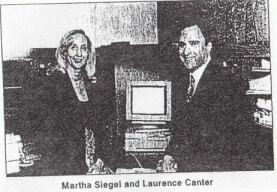 |
| Spam inventor Gary Thueck is still proud of his creation and makes appearances at industry conventions and trades shows where he is fawned over by conscienceless greed heads. |
On
May 3, 1978 Gary Thuerk—cursed be his name and all of his
decedents to the seventh generation—sent the first unsolicited mass business electronic
message shilling a new computer model
from Digital Equipment Corporation to
393 West Coast ARPANET users, most
of whom were ticked off. But he sold
a handful of pricy computers. A business model was born.
Commercial
messages had been sent before, but
each message was sent individually. Thurek, evidently a lazy jerk, casually asked a
subordinate—probably a harried secretary—to
use an ARPANET directory and just
send ‘em all out at once.
Around
the same time nerds with access to valuable computer time were playing multi-user Dungeons and Dragons games in
chatrooms. At least one disgruntled competitor for the shared
time came up with the idea of flooding the rooms with nuisance messages to shut
them down and prevent them from playing the game—a malicious use of mass messaging.
Both
developments were copied, slowly at
first, but picking up steam as more users hooked
up to what became known as the Internet.
The
term Spam for such activity came a
bit later, in the early ‘80’s. It was
first applied to the then popular Bulletin
Board discussion groups. Participants
wishing to silence another began to type the word Spam scrolling in long chains, forcing opponents’ entries far down, and
hopefully out of notice. Spam was used
in reference to the classic Monty Python
sketch where a waitress recites the menu—consisting entirely of the ersatz canned meat product accompanied
by a chorus of Vikings.
It
did not take long for the term to be applied to flooding Usenet newsgroups with unwanted messages. At first it was sort of pranking—Star Trek fans vs. Star Wars sort of thing. But
it turned malicious 1993 in response to the Automated Retroactive Minimal
Moderation (ARMM), software
intended to allow Usenet newsgroup administrators to somewhat
regulate abusive postings and ban offenders. Many regarded this as censorship and
in response Usenet was flooded with mass multiple messages which were
characterized as Spam.
By the mid 90’s increasingly Usenet was also being
flooded by Make Money Fastic chain letters.
 |
| Lawyers Martha Siegel and Laurence Canter spammed Usernet chat rooms, made a fortune peddling a how-to-get-rich-quick book for spammers, and went after critics with a vengeance. |
Spam on a really massive commercial scale was
credited to attorneys Laurence Canter and Martha Siegel who flooded newsgroups
with advertising for their immigration law practice. The so-called
Green Card spam was wide spread and harshly reviled. Defiant the
husband and wife lawyer team attacked their critics as censors and anti-capitalists. They also set themselves up as self-appointed experts in e-marketing authoring How to Make a Fortune on the Information
Superhighway, which
they marketed, naturally by Spam
messages.
As the Usenet and newsgroups faded with the rise in
popularity of e-mail spurred by America on Line (AOL) and then outfits
like Yahoo!, spam migrated there.
Soon elaborate
programs were developed to harvest e-mail
address and mass e-mail lists
were being peddled to big commercial users for huge amounts of money. There became a technological race between e-mail
service providers and spammers to filter
or ban the messages.
Today a majority
of most e-mail can broadly be
categorized as Spam. More if
messages sent to people who inadvertently
agreed to a “business relationship”
are added to those totally unsolicited.
It has literally driven users,
particularly younger folks, away
from e-mail entirely in favor of instant
messaging, phone texting, and social media platforms.
So, naturally, spamming has migrated to those
platforms. The proliferation of phishing schemes that harvest friends lists when users click on sucker bait posts or friend requests from phony or cloned accounts has become so widespread that it is undermining confidence in Facebook leading some experts to predict the ultimate collapse of the internet’s
most widely used social media platform.
Alternatives like Instagram, Redditt, and
Pinterest have all demonstrated vulnerabilities. Twitter handles are notoriously easy to harvest. Something of a haven just a few short years ago, cell phones are now flooded with unsolicited texts and robo-sales calls.
Many of these scams are merely annoying and having
your e-mail account or Facebook
identitity hijacked can requires hours of responding to messages from concerned
friends and in changing passwords
and security options. But for a tiny percentage, it means
having critical identification
information fall into the hands of criminals,
usually based in Russia or some
other safe haven country, who can empty checking and banking accounts in seconds or run up thousands of dollars on credit cards. This has meant absolute devastation to many
people not only pauperizing them but
almost irretrievably destroying the credit ratings.
And the spammers?
Well, they keep finding new ways
to get in your face whether you like it or not.
Happy birthday, indeed!
No comments:
Post a Comment